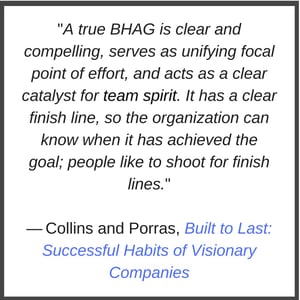 Building an ownership culture begins with defining and communicating organizational purpose and values, tying them to your performance management process, and rewarding employees for their contributions. Building a People Strategy around your ideal culture will generate change.
Building an ownership culture begins with defining and communicating organizational purpose and values, tying them to your performance management process, and rewarding employees for their contributions. Building a People Strategy around your ideal culture will generate change.
Part 2 of a 3-part series
Tie Culture to Performance Management
Identifying goals and rewarding employees for their accomplishments towards the goals directly influences and drives behaviors. Identifying a strategic goal, or better known as a Big Hairy Audacious Goal (BHAG), by Jim Collins; or True North, by Bill George, is an organization-wide goal which is clear and compelling and defines where the organization is headed.
A BHAG goal is often defined as a lag measure. A lag measure focuses on the end goal. It is a measure that defines what you are trying to accomplish. It is always in the past…..meaning at the time you are reporting the results of a lag measure, there is nothing more that can be done about it. Whereas, a lead measure focuses on measuring progress on activities that will ensure your end goal (BHAG) is met.
Cascading goals down the organization drive alignment. Consider using the S.M.A.R.T.E.R. goals acronym to identify goals at the employee level.
The first step in setting S.M.A.R.T.E.R. goals is to be specific – very specific. The more specific you are about your goals, the better and more able you’ll be to accomplish them no matter what method you use. This means that you don’t just say you want to make more money or lose more weight, you have to say exactly how much money you want to make or how much weight you want to lose. You have to put a real and exact figure on it. Make it measurable.
Step #2: “M” – Meaningful
The second step in setting S.M.A.R.T.E.R. goals is to set goals that are meaningful enough to you that you’ll get out there and do whatever it takes to achieve them. This is the “why” in goal setting. When your goals have a deep enough meaning to you, you’ll do whatever it takes to achieve them.
Step #3: “A” – Achievable
The third step in setting S.M.A.R.T.E.R. goals is to set goals that are achievable. When you’re setting goals, especially when they’re short-term goals (i.e. within 1 year), make sure that they’re achievable. This doesn’t mean that you can’t shoot for the stars in your long-term plans, such as 5 years down the road or even 10 years down the road. It just means that you have to pick goals that you can achieve in the short term.
Step #4: “R” – Relevant
The fourth step in setting S.M.A.R.T.E.R. goals is to set goals that are relevant. This means that the goals should be aligned with the overall organization or department goals and be in harmony with the organization's core values. A goal that does not drive business results and has no defined purpose is an activity that has no value, and should not be rewarded.
Step #5: “T” – Time-Bound
The fifth step in setting S.M.A.R.T.E.R. goals is to ensure that they’re time-bound goals. Set an exact date on when you plan to achieve these goals. When goals are time-bound, they’re measurable, and you should hold yourself accountable by measuring those goals on a daily, weekly, and monthly basis. How close are you to achieving your goals? How much further did you get from achieving your goals? Without making your goals time-bound and measurable, you won’t be able to see your progress.
Step #6: “E” – Evaluate
The sixth step in setting goals using the S.M.AR.T.E.R. method is to ensure that your goals are evaluated. By evaluating your goals routinely, you’ll be much more likely to achieve them. Set up a system for evaluating your goals and make the evaluation of your goals habitual. Don’t ignore this all-important step. Your mind has a very clever way of allowing you to ignore your goals by pushing you into emotion-numbing behaviors when those goals aren’t closely evaluated.
Step #7: “R” – Readjust
The final step in setting goals with the S.M.A.R.T.E.R. method is to readjust your approach. Readjust doesn’t mean that you have to throw your goals out and start all over. What it means is that you have to try different approaches until you find yourself getting closer and closer to your goals. That’s why constant evaluation is so important. If you don’t evaluate, you can’t measure your progress.
Establishing organization-wide goals and cascading them throughout the organization creates alignment and drives culture. How is your organization doing?
To download a simple template to create and monitor effective goals setting using the S.M.A.R.T.E.R. methodology, click below.


